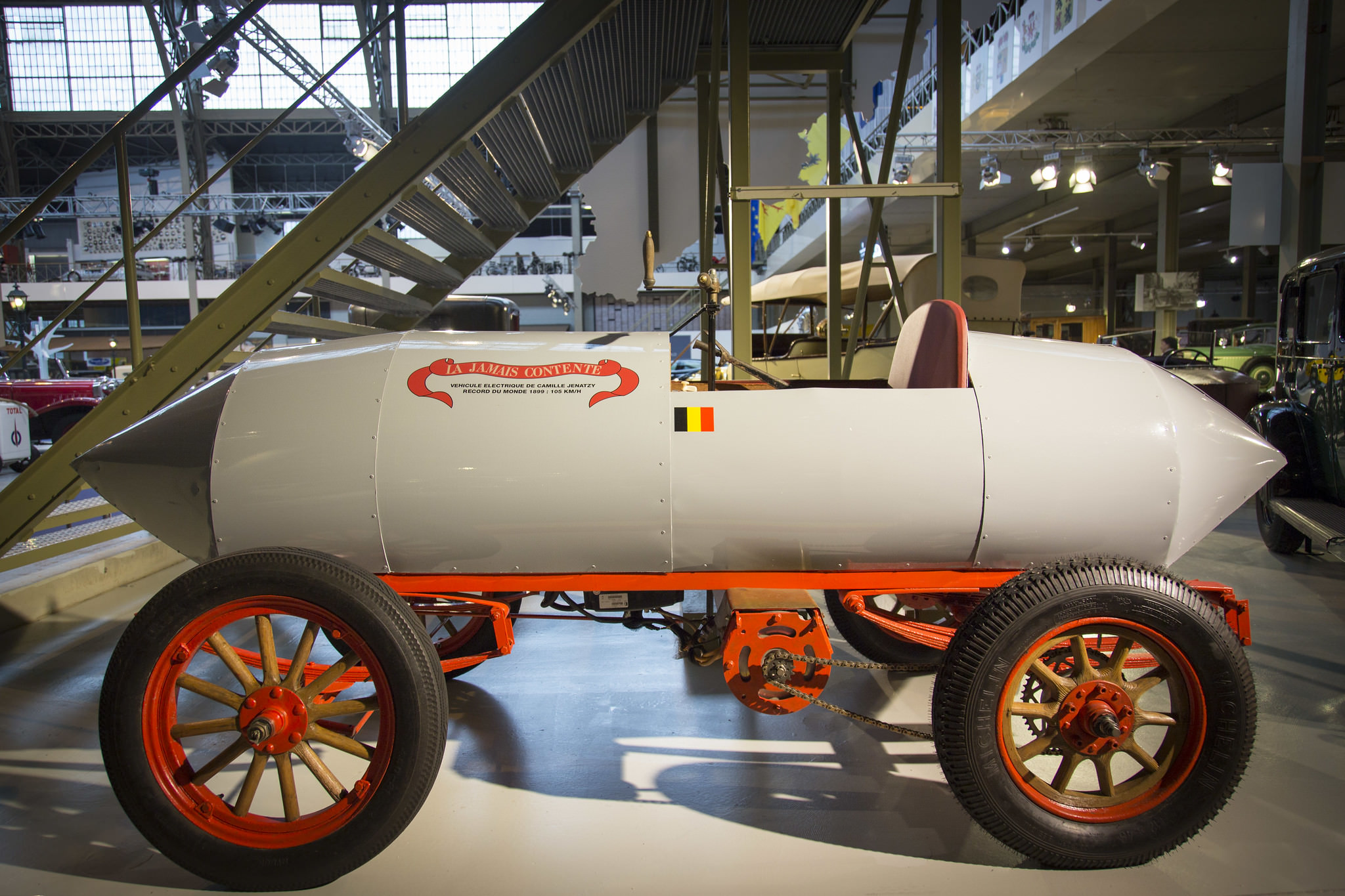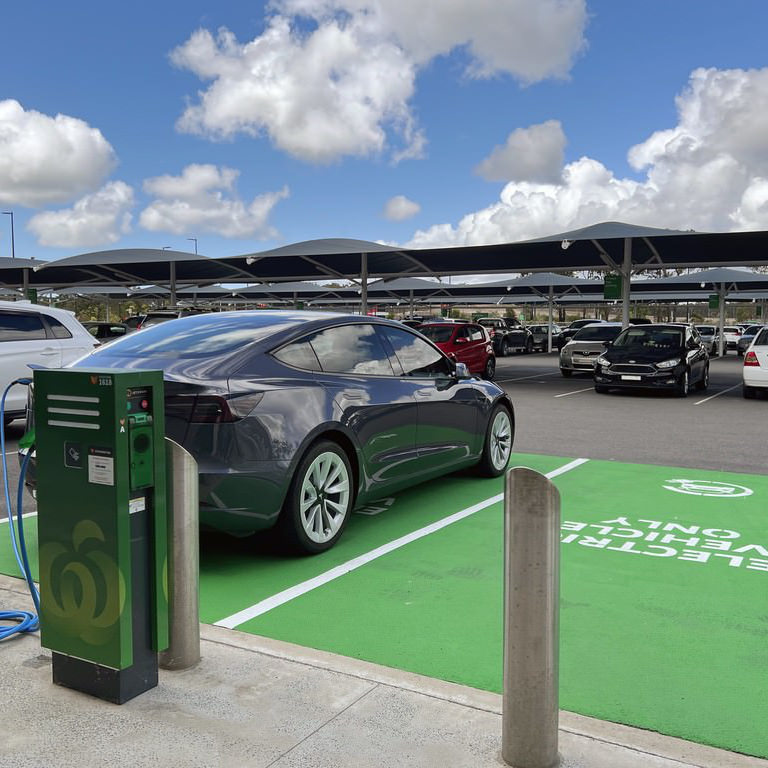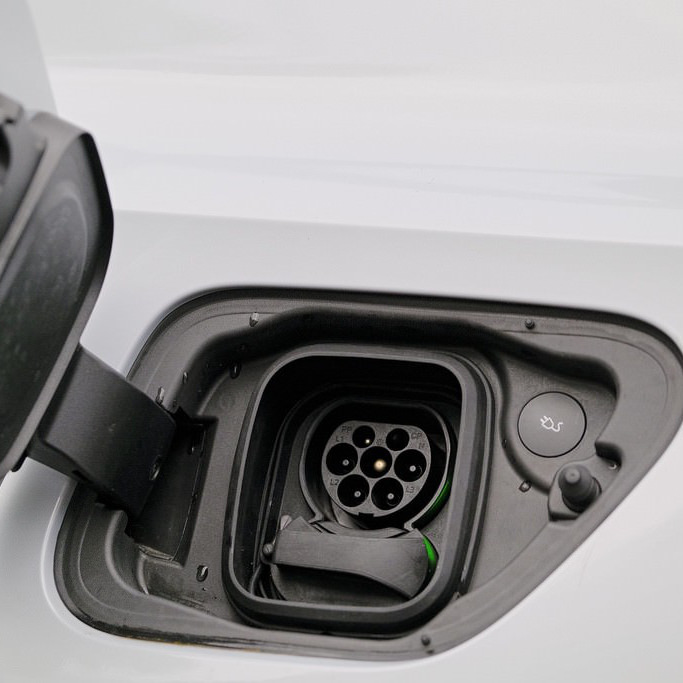The story of La Jamais Contente
La Jamais Contente (“The Never Satisfied”) was an electric car built and driven by Belgian engineer Camille Jenatzy, known as “Le Diable Rouge” (The Red Devil)[19]. On April 29, 1899, he reached 105.88 km/h (65.79 mph), becoming the first driver to exceed 100 km/h[1][2][3]. The car’s torpedo-shaped body and early use of lightweight alloys highlighted what electric propulsion could do during a period when combustion engines were gaining ground[4][5].
Competition within the emerging automotive industry shaped the car’s development. Jenatzy and the Jeantaud Company traded speed records, pushing each other toward new technical ideas[6][7]. La Jamais Contente used partinium for its body and relied on two electric motors, showing a design approach centered on weight reduction and direct power delivery[8][9].
Jenatzy died in 1913 after an accident unrelated to racing, but his work remained influential. La Jamais Contente survives in museums and is often referenced when discussing the early stages of electric mobility[10][11]. Its story reflects shifting attitudes toward speed and efficiency at the end of the 19th century[12].
The vehicle’s history also illustrates early interest in electric propulsion during a time of rapid mechanical experimentation[13][14].
Background
Camille Jenatzy: pioneer of electric racing
Camille Jenatzy, born in 1868 in Brussels, was trained as a civil engineer and became known for record attempts in electric cars. On April 29, 1899, he surpassed the 100 km/h mark in La Jamais Contente, reaching 105.88 km/h[1][2][3].
The innovation of La Jamais Contente
The car’s body used partinium, an aluminum-based alloy. Two Postel‑Vinay electric motors produced 50 kW (about 68 horsepower). Heavy Fulmen lead‑acid batteries weighing roughly 750 kg raised the total vehicle mass to about 1450 kg[2][20]. The streamlined form was unusual for the era and influenced later automotive shapes.
The racing context
Jenatzy set his record during an event held by La France Automobile in Achères near Paris. The uneven course required careful handling. Managing weight transfer and torque helped Jenatzy control the car at high speed[4][3].
Legacy and cultural impact
Jenatzy died in 1913 after a hunting‑related accident[4]. La Jamais Contente is displayed at the Automobile Museum in Compiègne[2][3]. Its design and performance mark an early stage of engineering thought that later shaped electric‑vehicle development.
Record‑breaking event
On April 29, 1899, Jenatzy reached 105.9 km/h (65.79 mph) in Achères, becoming the first driver to pass 100 km/h in an electric car[7][8]. His rivalry with Chasseloup‑Laubat produced a series of increasing records during the months before the attempt[8][9].
Jeantaud set 63.13 km/h in December 1898. Jenatzy then continued to raise the mark, reaching 105.878 km/h in April 1899 after repeated attempts[8]. The competition encouraged rapid mechanical refinement[9].
La Jamais Contente used two motors delivering 50 kW directly to the front wheels[10]. The car showed that electric propulsion could produce high performance, a point that resonates with ongoing work in sustainable vehicle design[11].
Jenatzy’s result became a reference point for later record attempts and for the development of high‑speed automotive engineering[9][11].
Cultural and historical context
La Jamais Contente’s achievement occurred during years of fast mechanical experimentation. Electric vehicles competed directly with gasoline cars for performance and reliability[2][1]. The partinium body and high‑output motors highlighted material and design choices that were new to the public[13][2].
Record attempts by competing manufacturers shaped public perception. Jeantaud set 63.15 km/h in December 1898, followed by Jenatzy’s successive increases during early 1899[9][8]. The rivalry encouraged investment in new techniques and materials.
A shift in cultural values
Speed was becoming associated with modern life. The push for faster transportation reflected growing urban movement and interest in long‑distance travel[11]. New vehicle designs shaped how people imagined mobility.
La Jamais Contente continues to be cited in discussions about electric‑vehicle design[13][2]. Its record introduced ideas that later influenced aerodynamics and powertrain engineering.
Psychological aspects of speed
Record attempts often involve a personal search for challenge and achievement. High‑speed driving produces intense physical sensations. Jenatzy said the car felt as if it were “leaving the ground and hurling itself forward like a projectile”[14].
Recognition played a role in Jenatzy’s efforts. His rivalry with Chasseloup‑Laubat shows how competition could motivate engineering changes and repeated attempts at improvement[13]. Driving at such speeds created physical strain. Jenatzy described muscle rigidity and heightened alertness while controlling the car[15]. Public interest in speed affected the psychological environment of racing. Early cars symbolized progress, and spectators followed record attempts closely[9].
Legacy
La Jamais Contente, the first car to exceed 100 km/h in 1899, remains a notable example of early electric‑vehicle performance[16][13].
Modern interest in electric mobility often references early experiments like Jenatzy’s. The record demonstrated that electric motors could support high‑performance driving[17][13]. Work on integrating electric powertrains with new control systems continues this line of development[17]. During the 1920s and 1930s, aerodynamic experiments grew in scope. La Jamais Contente anticipated some of these ideas through its streamlined form[5].
The car is held at the National Car and Tourism Museum in Compiègne[13]. Discussions about sustainable transportation often refer back to early electric vehicles when tracing the development of modern mobility[10][18].
References
[1]: Foley Motorsports
[2]: MIP
[3]: Moba
[4]: Vanderbilt Cup Races
[5]: V&A
[6]: Escuderia
[7]: FIA Formula E
[8]: New Atlas
[9]: Discovery UK
[10]: Prestige Electric Car
[11]: Bosch
[12]: Design You Trust
[13]: Classic Car Maintenance
[14]: MotorTrend
[15]: Jenatzy Story
[16]: YouTube
[17]: Contrary Research
[18]: RCA Research
[19]: Motorsport Memorial
[20]: Wikipedia








